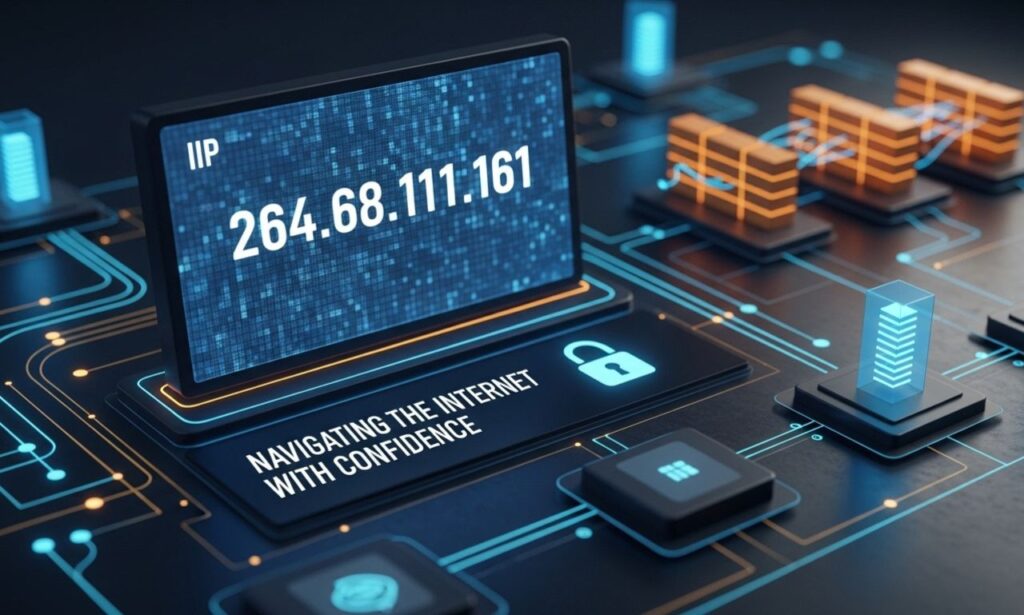In today’s digital landscape, navigating the internet can feel like exploring a vast and uncharted territory. At the heart of this journey are IP addresses, unique identifiers that help connect devices to networks. Among them is 264.68.111.161—an intriguing example that opens up discussions about how we interact with technology daily.
Understanding what an IP address is and how it functions can empower you to surf the web with confidence. Whether you’re streaming your favorite show, online shopping, or simply browsing for information, knowing more about these numerical codes enhances your online experience and security. Let’s dive deeper into the world of IP addresses and unravel their mysteries together!
What is 264.68.111.161?
264.68.111.161 is an Internet Protocol (IP) address that serves as a unique identifier for devices connected to the internet.
Every device online requires an IP address, acting like a digital home address to send and receive information accurately. When you navigate the web, your requests are routed through this numerical system.
This specific IP address falls within the IPv4 format, which consists of four sets of numbers separated by periods. Each set ranges from 0 to 255, allowing for over four billion possible addresses.
While it’s easy to overlook such technical details, understanding IP addresses can enhance your internet experience significantly. Whether you’re streaming videos or browsing websites, recognizing how they function adds another layer of appreciation for our interconnected world.
Understanding the Components of an IP Address
An IP address consists of several key components that serve unique purposes. Each part plays a crucial role in identifying devices on the internet.
Typically, an IP address is divided into four sections. These are separated by dots and consist of numbers ranging from 0 to 255. Each segment represents a different piece of information about the device’s network location.
The first part often indicates the network itself, while the subsequent segments identify individual devices within that network. This hierarchical structure allows for efficient routing of data across vast networks.
Additionally, there are two primary types: IPv4 and IPv6. While IPv4 uses a 32-bit format with four octets, IPv6 employs a more complex system to accommodate our growing number of internet-connected devices.
Understanding these elements helps demystify how we connect online each day.
How IP Addresses Work
IP addresses function like digital postal addresses. They help devices communicate over the internet by identifying them uniquely.
When you connect to a network, your device is assigned an IP address. This allows data packets to be sent and received accurately. Each packet contains information about its source and destination.
Think of it as sending a letter through the mail. The address on the envelope ensures it reaches the right person. Similarly, an IP address directs traffic across networks.
There are two main types: IPv4 and IPv6. IPv4 consists of four sets of numbers separated by periods, while IPv6 offers a much larger range with alphanumeric combinations.
This transition was necessary due to the exponential growth of Internet-connected devices, ensuring everyone stays connected seamlessly without confusion or overlap in addresses.
Types of IP Addresses (Public vs Private)
IP addresses come in two main types: public and private. Understanding the difference is crucial for navigating today’s digital landscape.
Public IP addresses are assigned by your Internet Service Provider (ISP) and allow devices to communicate over the internet. These addresses are unique across the entire web, making them essential for accessing websites and online services.
On the other hand, private IP addresses operate within a local network. They enable devices like computers, printers, and smartphones to connect with each other without needing exposure to the outside world. This setup enhances security while allowing easy communication among connected devices.
Each type of address plays a vital role in how we use technology daily. Knowing when to utilize either can help improve both performance and safety as you explore online spaces.
The Importance of Security in IP Addresses
The importance of security in IP addresses cannot be overstated. Each time you connect to the internet, your device broadcasts its IP address. This unique identifier can expose you to various risks if not properly secured.
Cybercriminals often target unprotected devices through their IP addresses, seeking personal information or sensitive data. Without adequate protection, users become vulnerable to hacking attempts and identity theft.
Employing strong security measures is crucial. Firewalls, VPNs, and encryption tools help safeguard your online presence by obscuring your IP address from prying eyes. Regularly updating software also plays a vital role in defending against potential threats.
Awareness is key when navigating the digital landscape. Understanding how IP security works empowers individuals to take proactive steps toward their safety while enjoying all that the internet has to offer.
Tips for Protecting Your Personal Information Online
Protecting your personal information online is essential in today’s digital landscape. Start by using strong, unique passwords for each of your accounts. Avoid common phrases and include a mix of letters, numbers, and symbols.
Enable two-factor authentication whenever possible. This adds an extra layer of security that can prevent unauthorized access to your accounts.
Be cautious when sharing personal details on social media platforms. Adjust privacy settings to limit who can view your information and posts.
Regularly update software and applications on all devices you use. Updates often contain critical security patches that protect against vulnerabilities.
Always be wary of phishing attempts through emails or messages claiming to be from legitimate sources. Verify their authenticity before clicking any links or providing sensitive information. Keeping these tips in mind will help safeguard your online presence significantly.
Embracing the Digital World with Confidence
Embracing the digital world is an exhilarating journey. With a universe of information at our fingertips, every click opens new possibilities.
Understanding your IP address, like 264.68.111.161, can empower you to navigate with assurance. This knowledge serves as a foundation for exploring online spaces safely.
When you’re aware of potential risks and how to mitigate them, it transforms your experience from daunting to delightful.
Engaging in this vast network encourages curiosity and learning while fostering connections across continents. Social media platforms, forums, and educational sites are just the beginning.
Confidence comes from awareness—knowing how technologies work helps demystify the web’s complexities. As you embrace each aspect of online existence, 264.68.111.161 remember that safety practices enhance not only security but also enjoyment in this digital age.
Every step taken towards understanding enriches your experience and allows for greater exploration without fear or hesitation.
Conclusion
Understanding the intricacies of IP addresses is essential in today’s digital landscape. The address 264.68.111.161 serves as a prime example of how these numerical strings function within the broader context of internet navigation.
By breaking down its components, we gain insights into what makes up an IP address and how it interacts with networks around the globe. Knowing whether you’re dealing with a public or private IP can significantly impact your online activities and security.
Security remains a top priority when navigating the digital world. Protecting personal information should be at the forefront of everyone’s online experience. Simple measures like using strong passwords, enabling two-factor authentication, and being cautious about sharing sensitive data can go a long way in safeguarding your privacy.
As you embrace technology and engage more deeply with the internet, understanding concepts like those surrounding 264.68.111.161 will empower you to navigate confidently while remaining aware of potential risks involved in this vast online ecosystem.
Staying informed is not just advantageous; it’s necessary for creating safer experiences as users continue to explore everything that our interconnected world has to offer.






